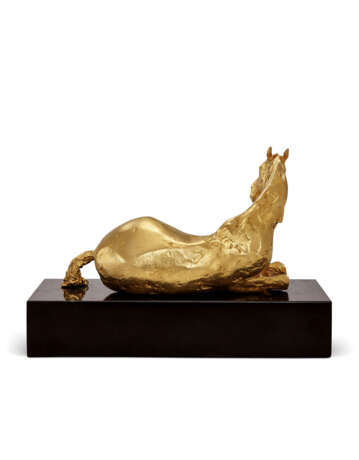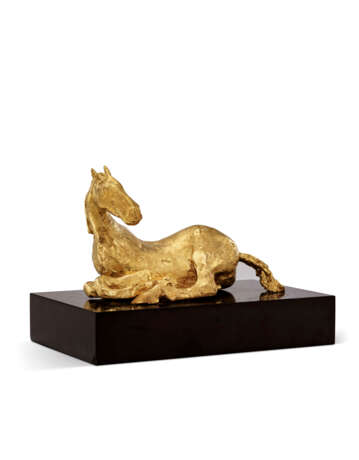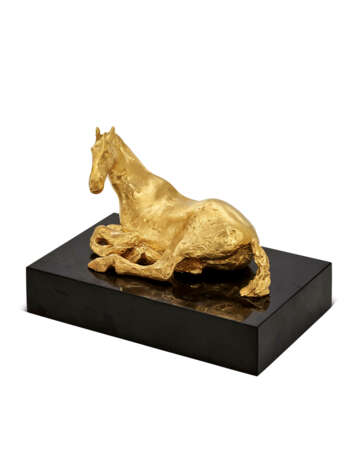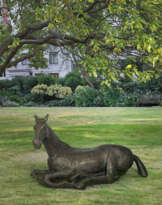ID 831372
Lot 235 | DAME ELISABETH FRINK, R.A. (1930-1993)
Valeur estimée
£ 100 000 – 150 000
Rolling Over Horse
signed and numbered 'Frink/ 11/12' (on the underside), numbered and stamped with foundry mark, London hallmark for 18 carat gold and date letter for 1973 'MSFLD/18/S' (on the underside of the left hind leg)
18 carat yellow gold, on a black stone base
8 in. (22.9 cm.) long, excluding base
Conceived in 1972 and cast in 1973 by Morris Singer Foundry, London.
Provenance
Commissioned by Morris Singer Foundry, London and Christie’s Contemporary Art, London, in 1972, where purchased by the father of the present owner in the early 1970s, and by descent.
Literature
B. Robertson (intro.), Elisabeth Frink Sculpture: Catalogue Raisonné, Salisbury, 1984, pp. 180-181, no. 207, another cast illustrated.
A. Ratuszniak (ed.), Elisabeth Frink: Catalogue Raisonné of Sculpture 1947-93, Farnham, 2013, p. 125, no. FCR234, another cast illustrated.
Exhibited
London, Alwin Gallery, Bronze, Silver & Gold, August - September 1973, no. 12, another cast exhibited.
Special notice
Artist's Resale Right ("Droit de Suite"). Artist's Resale Right Regulations 2006 apply to this lot, the buyer agrees to pay us an amount equal to the resale royalty provided for in those Regulations, and we undertake to the buyer to pay such amount to the artist's collection agent.
Post lot text
Elisabeth Frink was fascinated by the ‘strength, fidelity, and sagacity’ of horses throughout her life (E. Lucie-Smith, Elisabeth Frink: Sculpture since 1984 and Drawings, 1994, p. 40). The present work is a delightful example of the artist’s enduring connection with animals, and particularly horses.
In the early 1970s, the London founders, Morris Singer Sculpture Association Ltd., with Christie’s Contemporary Art, commissioned eight artists to choose a subject representative of their oeuvre, and to produce sculptures in an edition of twelve, no longer than twelve inches in width, and cast in 18 carat yellow gold. The eight artists included the most celebrated British sculptors of the time, among them: Elisabeth Frink, Lynn Chadwick, Barbara Hepworth, Kenneth Armitage and Michael Ayrton (see lot 119).
Frink saw the commission as an opportunity to create a small equestrian sculpture which did not sacrifice artistic principle. Indeed, the artist’s expressive rendering of the horse’s physicality, from the slight tension in its neck, to the curling of its legs, strikingly reveals its transitionary movement from repose to action. The startling luminosity of the sculpture’s yellow gold medium heightens this physical immediacy, as undulations of the horse’s musculature are thrown into shadow, resulting in a sculpture instilled with real character.
Horses began to appear in Frink’s subject matter at the end of the 1960s, shortly after she went to live in the Camargue in the South of France. Celebrated for its herds of semi-wild horses, this isolated area proved an important source of inspiration for Frink, reawakening childhood memories growing up surrounded with horses in the Suffolk landscape. Interestingly, it was at this time that Frink began to ride again for the first time since giving it up at the age of sixteen. This renewed connection with horses ignited an intimacy with their behaviour when not in control of mankind that continued until the very end of her career.
| Artiste: | Elisabeth Frink (1930 - 1993) |
|---|---|
| Matériel: | Or |
| Style artistique: | Art moderne |
| Artiste: | Elisabeth Frink (1930 - 1993) |
|---|---|
| Matériel: | Or |
| Style artistique: | Art moderne |
| Adresse de l'enchère |
CHRISTIE'S 8 King Street, St. James's SW1Y 6QT London Royaume-Uni | |
|---|---|---|
| Aperçu |
| |
| Téléphone | +44 (0)20 7839 9060 | |
| Commission | see on Website | |
| Conditions d'utilisation | Conditions d'utilisation |














